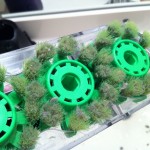CaPRéT: Getting to the Alpha Release
When a user cuts and pastes text from a CaPRéT-enabled site:
- The user gets the text as originally cut, and if their application supports it, the pasted text will also automatically include attribution and licensing information.
- The OER site can also track what text was cut, allowing them to better understand how users are using their site.
When we proposed this work, we knew that the concept was possible but we didn’t’ know exactly how we might go about doing it.
The Workplan
- We divided the project work up into phases.
- Will it work?: Can we come up with an efficient way to insert attribution and/or license into the clipboard?
- Basic Functionality: Now that we know we can affect the clipboard, let’s write in basic attribution and license information building on OpenAttribute.
- Basic Analytics: Let’s present some basic analytics as to how users are cutting and pasting OER content.
- Limited Trials: Let’s deploy the code at some test sites to see how it works and get feedback. Rapidly refine and update the functionality.
- Widespread Availability: Release client and server side code.
In late May 2011 we identified the following tasks to begin to address the first three phases.
- Figure out how to copy/paste and add to copy to the clipboard buffer.
- Figure out how to generate and add analytics at copy/paste moment. This might require some type of asynchronous or client side process so that we can work fast and not mess up the user experience. Including: generate a hash tag client side, embed hash tag as a URL parameter for an image request, and after the copy is done send data to the server and associate the hash tag with the URL and the text copied.
- Parse an embedded license client side when the page. Issues that we identified included: Need to figure out what that looks like in client page. Is it visible? Is it RDF? How do we scope the license to only the items that were copied and not to the entire page?
- Pass the license at copy/paste time.
- We’ll need to build a simple server side application that gathers up all this data.
Things went pretty well and with a little bit of work, we completed the first three steps (in late-July/early-August 2011) and just announced an alpha release that includes client side javascript to be embedded in a site, server side code to track use as well as code to display a basic set of analytics.
We have a working demo at: http://capret.mitoeit.org/ and the code is available at: https://github.com/tatemae/capret under a MIT License.
How does it work?
CaPRéT uses the jQuery library and a jQuery clipboard extension to monitor the copy event on a given web page. At the time content is copied, the extension adds attribution information that was parsed from the page using the OER license parser. In addition, analytics are gathered at the time content is copied so that even if the user chooses to remove the attribution information the server still gathers information that indicates the content was used. If the user pastes the code into another webpage (and does not remove the attribution information) then a small tracking code is included which records views of the copied content.
Next Steps
We’re in the limited trials phase. We’ve posted the announcement to the JISC oer-discuss list and let a few selected colleagues know that it’s available for testing.
The next steps in the workplan:
- Basic Analytics: We have basic, realtime analytics working, but are still in the process of setting them up on a public server. (By late-August 2011)
- Limited Trials: In addition to public feedback, we’ll be testing this out on a number of sites including Project Greenfield (http://greenfield.mit.edu/, a mirror of MIT OpenCourseWare) and at OER Glue. (August-September 2011)
- Refinement: Compile public feedback, and results of limited trials to refine software. (September 2011)
- Widespread Availability: Release stable client and server side code. (By mid-October 2011)

